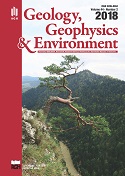Using on-line analyzers and RAC parameters to determine the amount of TN and TP pollutants discharged from Poland into the Baltic Sea
DOI:
https://doi.org/10.7494/geol.2018.44.2.209Keywords:
Total Nitrogen (TN), Total Phosphorus (TP), surface water monitoring, River Absorption Capacity (RAC)Abstract
Despite the numerous measures taken to protect its environment for many years, Poland is among the top countries with the largest contributing share in the pollution of the Baltic Sea. It is undoubtedly the case that we are dealing with excesses in the permissible concentrations of total nitrogen (TN) and total phosphorus (TP) on many sections of Polish rivers. However, in order to be able to thoroughly analyze this problem, it is first necessary to increase the frequency of TN and TP monitoring in surface waters. The article presents the first results obtained from the TN and TP monitoring system launched in 2016 at the IMGW-PIB on the calculation profile Szczecin (the Odra River) and Tczew (the Vistula River). The on-line analyzers installed for this purpose make it possible to perform measurements several times a day, allowing for the assessment of diurnal and seasonal variations of TN and TP. Using the results obtained, the daily values of the River Absorption Capacity (RAC) parameter were also calculated. The obtained results showed that, in general, the value of the RAC parameter on the analyzed calculation profiles was positive for both TN and TP throughout the entire period, irrespective of the time of year.
Downloads
References
Abbaspour K.C., Rouholahnejad E., Vaghefi S., Srinivasan R., Yang H. & Kløve B., 2015. A continental-scale hydrology and water quality model for Europe: Calibration and uncertainty of a high-resolution large-scale SWAT model. Journal of Hydrology, 524, 733–752.
Ahn S.R. & Kim S.J., 2017. Assessment of integrated watershed health based on the natural environment, hydrology, water quality, and aquatic ecology. Hydrology and Earth System Sciences, 21, 11, 5583–5602.
Ahtiainen H., Artell J., Elmgren R., Hasselström L. & Håkansson C., 2014. Baltic Sea nutrient reductions – What should we aim for?. Journal of Environmental Management, 145, 9–23.
Andersen J.H., Carstensen J., Conley D.J., Dromph K., Fleming‐ Lehtinen V., Gustafsson B.G. & Murray C., 2017. Long‐term temporal and spatial trends in eutrophication status of the Baltic Sea. Biological Reviews, 92(1), 135–149.
Andrulewicz E., 2001. Monitoring środowiska morskiego Bałtyku – rys historyczny (do 2000 r.). Morski Instytut Rybacki w Gdyni, [on-line:] http://docplayer.pl/ 12660129-Monitoring-srodowiska-morskiego-baltyku-rys-historyczny-do-2000-r-eugeniusz-andrulewicz.html.
Duarte C.M., Conley D.J., Carstensen J. & Sanchez-Camacho M., 2009. Return to Neverland: shifting baselines affect eutrophication restoration targets. Estuaries and Coasts, 32, 1, 29–36.
HELCOM, 2015. Updated Fifth Baltic Sea pollution load compilation (PLC-5.5). Baltic Sea Environment Proceedings, 145, Baltic Marine Environment Protection Commission, Helsinki, [on-line:] http://www.helcom.fi/ Lists/Publications/BSEP145_lowres.pdf.
Ji Z.G., 2017. Hydrodynamics and water quality: modeling rivers, lakes, and estuaries. John Wiley & Sons.
Kiedrzyńska E., Kiedrzyński M., Urbaniak M., Magnuszewski A., Skłodowski M., Wyrwicka A. & Zalewski M., 2014. Point sources of nutrient pollution in the lowland river catchment in the context of the Baltic Sea eutrophication. Ecological Engineering, 70, 337–348.
Kundzewicz Z.W., 2001. Water problems of central and eastern Europe-a region in transition. Hydrological Sciences Journal, 46, 6, 883–896.
Loga M., 2016. Wody pod presją. Wydział Instalacji Budowalnych, Hydrotechniki i Inżynierii Środowiska, Politechnika Warszawska, Warszawa.
Ostojski M.S., 2012. Modelowanie procesów odprowadzania do Bałtyku związków biogennych: na przykładzie azotu i fosforu ogólnego. Wydawnictwo Naukowe PWN, Warszawa.
Ostojski M.S., Gębala J., Orlińska-Woźniak P. & Wilk P., 2016. Implementation of robust statistics in the calibration, verification and validation step of model evaluation to better reflect processes concerning total phosphorus load occurring in the catchment. Ecological Modelling, 332, 83–93.
Rovira J.L. & Pardo P., 2006. Nutrient pollution of waters: eutrophication trends in European marine and coastal environments. Contributions to Science, 3, 2, 181–186.
Sapek A., 2008. Źrodła substancji wprowadzanych rzekami z Polski do Morza Bałtyckiego. Woda-Środowisko-Obszary Wiejskie, 8, 151–161.
Smith B., Lindeskog M., Engstrom K., Olin S. & Poska A., 2016. Robustness and uncertainty in future nutrient loads from land ecosystems across the Baltic Sea catchment area. [in:] Reckermann M. & Koppen S. (eds.), 1st Baltic Earth Conference Multiple Drivers for Earth System Changes in the Baltic Sea Region: Nida, Curonian Spit, Lithuania, 13–17 June 2016: conference proceedings, International Baltic Earth Secretariat Publication, 9, International Baltic Earth Secretariat, Geesthacht, 59.
Tynkkynen N., Schonach P., Pihlajamaki M. & Nechiporuk D., 2014. The governance of the mitigation of the Baltic Sea eutrophication: Exploring the challenges of the formal governing system. Ambio, 43, 1, 105–114.
Wilk P., 2015. Metoda obliczania chłonności rzeki jako narzędzie do oceny stanu fizykochemicznego powierzchniowych wód płynących. IMGW-PIB [Ph.D. Thesis].
Wilk P., Gębala J., Orlińska-Woźniak P. & Ostojski M., 2016. The importance of hourly nutrient concentration variability in terms of assessment of the surface water state in Słupia Pilot River. Meteorology Hydrology and Water Management. Research and Operational Applications, 4, 13–24.
Wilk P., Orlińska-Woźniak P. & Gębala J., 2017a. Zmienność stosunku stężeń azotu i fosforu dla wybranych zlewni rzek przymorza. Przegląd Naukowy. Inżynieria i Kształtowanie Środowiska, 26, 1[75], 55–65.
Wilk P., Orlińska-Woźniak P., Gębala J. & Ostojski M., 2017b. The flattening phenomenon in a seasonal variability analysis of the total nitrogen loads in river waters. Czasopismo Techniczne, 11, 137–159.
Downloads
Published
Issue
Section
License
Authors have full copyright and property rights to their work. Their copyrights to store the work, duplicate it in printing (as well as in the form of a digital CD recording), to make it available in the digital form, on the Internet and putting into circulation multiplied copies of the work worldwide are unlimited.
The content of the journal is freely available according to the Creative Commons License Attribution 4.0 International (CC BY 4.0)










